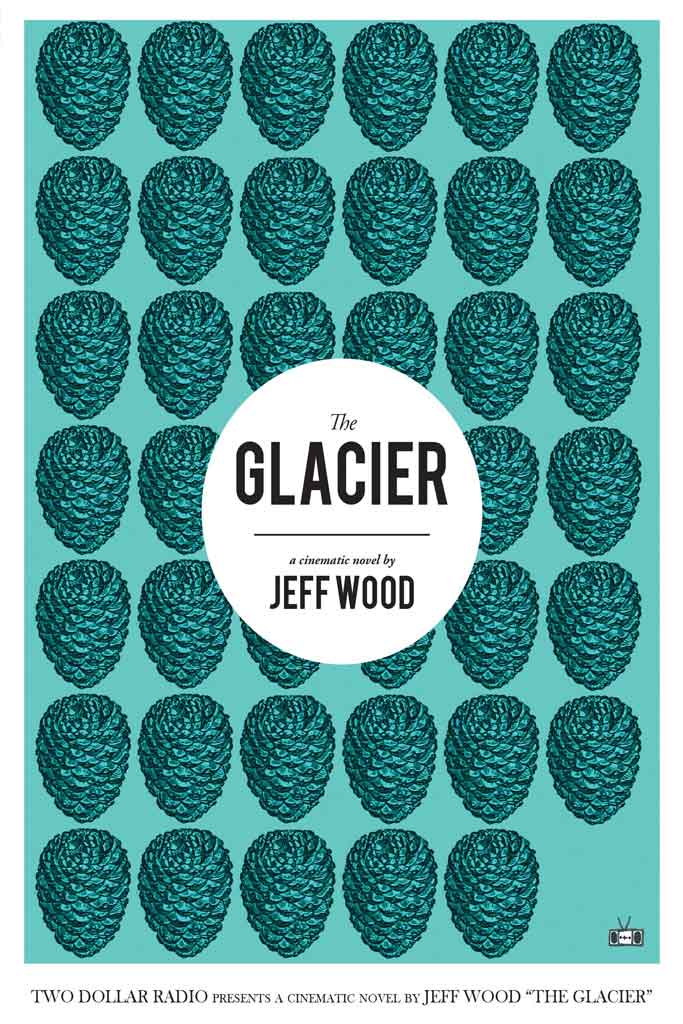Review by Joe Seale // August 1, 2016
Two Dollar Radio, Oct. 2015
Paperback, 160 pp., $15.95
The early pages of Jeff Wood’s cinematic novel The Glacier depict a landscape rearranged through a series of instantaneous and radical changes. Jonah, the character who comes closest to serving as a protagonist, works hundreds of yards away from his fellow surveyors, plotting more houses for a cookie-cutter suburban neighborhood that already spreads as far as the eye can see. The narrative lens then pans across multiple characters for brief 1-2 sentence snapshots that resemble a series of jump-cuts in a film, building suspense while disorienting the reader until, in a “ferocious and beautiful…spectacle,” everything disintegrates, evaporates: the world is abruptly destroyed. The viewpoint comes back to Jonah just before he is consumed by the wall of atomic fire. He calmly watches the destruction spread until it reaches him. He simply utters the word “Wait,” and “The Apocalypse pauses.” For the duration of an entire paragraph, the reader is trapped with Jonah “radiating between two worlds,” a pause just long enough to ponder the beauty of the moment, before he becomes a charred skeleton like the rest. But then something peculiar happens. The mushroom cloud implodes, the fiery wave flows backwards, bodies and atoms reassemble. The world reconstructs itself, leaving its inhabitants dazed by the lost moment, by “what may or may not have just happened”—the Event has occurred.
What it means to “occur” in this book is hard to pin down, however. Rather than proceeding along a linear chronology, The Glacier takes the reader on a journey through and around time. (“It is coming,” the Radiation Man tells Jonah, “But it has also already happened. And it is happening all the time now.”) In this non-post-apocalyptic world, time works differently (or not at all), and the world feels like a different color on the page. What happens to space, too, is both warped and consequential. Before the Event, a small child runs out of his house to play in green field only to find his way blocked by “the monolithic wall of vinyl siding” from a subdivision that has seemingly appeared out of nowhere, the same subdivision Jonah stands in during the Event. This housing project, the rows and rows of houses, “the gray, suburban expanse…sprawl[s] endlessly toward the horizon of gauze and ozone,” ultimately filling a vacancy that the Event exposes in a flash like a camera in a dark room. With such patterning—expansion, destruction, expansion—Wood utilizes a fantastical depiction of the unceasing encroachment of suburbanization to explore what it means to be human in a world that has lost sight of itself as a result of constant development.
One method Wood uses to emphasize this lost sense of self is the very structure of the novel. The Glacier is written in the format of a screenplay—what its publisher, Two Dollar Radio, calls “a cinematic novel.” The form allows Wood to blend the seamless and fluid movement of film with the creative flexibility and intimacy of prose. With its blocks of dialogue surrounded by swaths of blank space, the format can invoke disorientation. For setting, readers are given stage directions, and beyond the dialogue the only gateways inside the characters are brief facial expressions or a few parenthetical descriptions (“whispering frantically”). But despite having the look, feel, and pace of a script, The Glacier reads very much like a novel, even as it leverages the screenplay format to allow for abrupt jump cuts and shifting angles, producing a 360-degree view of a world that might otherwise appear flat on the pages of a traditional work of prose fiction.
If, in the normal process of reading a novel, the reader is a co-creator of the story (by merging the author’s vision with his own), the cinematic novel only accentuates this process. It assumes an even greater level of co-creation, or co-imagination, on the part of the reader, just as a script assumes a greater level of co-creation on the part of the director and crew. In short, the reader has to (or depending on your outlook, gets to) do a little more work to fill in the spaces Wood leaves blank. Much like a blueprint gives only a certain understanding of what a building really looks like, Wood’s cinematic novel provides all the necessary pieces but leaves the assembly up to the reader.
In addition to this phenomenon of readerly co-construction, The Glacier highlights a seemingly opposite theme of self-destruction. Near the end of the novel, Jonah describes the “something” that has happened/is happening/looms in the future, as a situation where “We’re conspiring to engineer the annihilation of ourselves.” But, for both characters and readers, these two processes—co-creation and self-annihilation—are in many ways related. One of the primordial pleasures for many readers is the sensation of the self disappearing during the reading process—the feeling that when we’re really, truly immersed in a book, a type of annihilation of self naturally occurs. In this sense, Wood’s book may suggest that losing sight of ourselves might not always be a bad thing.
ABOUT THE REVIEWER
Joe Seale is a writer and critic working on his PhD in the Creative Writing Program at the University of Georgia, where he currently serves as the Assistant to the Director of the Writing Intensive Program. He received his MA from the University of Tennessee-Knoxville in 2014 and his BA from the University of West Alabama in 2011. An author primarily of short stories, Joe is now working on his first novel, and his primary research areas are Southern and African American literature, with a focus on gender and race studies. His work has appeared or is forthcoming in The Spark, Dead Mule, The Southern Tablet, Red Fez, The Emerson Review, Eunoia, and others.






